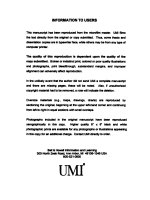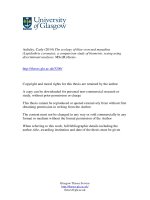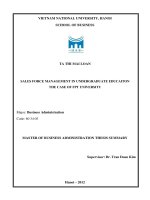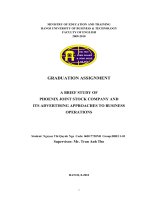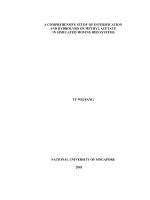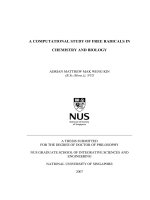A phenomenological study of challenge related lived experiences of female students with visual impairment in higher education the case of addis ababa university
Bạn đang xem bản rút gọn của tài liệu. Xem và tải ngay bản đầy đủ của tài liệu tại đây (843.73 KB, 85 trang )
ADDIS ABABA UNIVERSITY
COLLEGE OF SOCIAL SCIENCES
SCHOOL OF SOCIAL WORKS
A PHENOMENOLOGICAL STUDY OF CHALLENGE-RELATED LIVED EXPERIENCES OF
FEMALE STUDENTS WITH VISUAL IMPAIRMENT IN HIGHER EDUCATION
THE CASE OF ADDIS ABABA UNIVERSITY
By: Tilahun Kifle
Advisor: Dr. Asmamaw G/Egziabher
June, 2017
Addis Ababa, Ethiopia
A PHENOMENOLOGICAL STUDY OF CHALLENGE-RELATED LIVED EXPERIENCES OF
FEMALE STUDENTS WITH VISUAL IMPAIRMENT IN HIGHER EDUCATION
THE CASE OF ADDIS BABA UNIVERSITY
By
Tilahun Kifle
A THESIS SUBMITTED TO GRADUATE SCHOOL OF SOCIAL WORK OF ADDIS ABABA
UNIVERSITY IN FULFILLMENT OF THE REQUIREMENTS FOR THE DEGREE OF
MASTERS IN SOCIAL WORK (MSW)
June, 2017
DECLARATION
I declare that this thesis is my own work. All citations, references and borrowed ideas have
been duly acknowledged. It is being submitted in fulfillment of the requirements for the
degree of Master of Social Work, in the Graduate Program at Addis Ababa University, Addis
Ababa, Ethiopia. None of the present work has been submitted previously for any degree or
examination in any other University.
Tilahun Kifle
_____________________
Signature
ADDIS ABABA UNIVERSITY
SCHOOL OF GRADUATES STUDIES
COLLEGE OF SOCIAL SCIENCES
SCHOOL SOCIAL WORK
A PHENOMENOLOGICAL STUDY OF CHALLENGE-RELATED LIVED EXPERIENCES OF
FEMALE STUDENTS WITH VISUAL IMPAIRMENT IN HIGHER EDUCATION
THE CASE OF ADDIS ABABA UNIVERSITY
By Tilahun Kifle
Approved by Board of Examiners
Chairman, Department of Graduate Committee
Signature
Advisor
Signature
External Examiner
Signature
Internal Examiner
Signature
TABLE OF CONTENTS
ACKNOWLEDGMENT ..................................................................................................................i
ACRONYMS ................................................................................................................................. ii
ABSTRACT ................................................................................................................................... iii
Chapter One...................................................................................................................................... 1
1. Introduction ............................................................................................................................... 1
1.1 Background of the Study .................................................................................................... 1
1.2 Statement of the Problem ................................................................................................... 3
1.3 General Objectives of the Study ........................................................................................ 5
1.4 Specific objectives of the Study .......................................................................................... 5
1.5 Research Questions ............................................................................................................. 6
1.6 Significance of the Study .................................................................................................... 7
1.7 Justification ........................................................................................................................ 7
1.8 Limitations .......................................................................................................................... 7
Chapter Two ..................................................................................................................................... 9
2. Review of the Related Literature ............................................................................................... 9
2.1 Understanding the Concept of Disability .......................................................................... 10
2.2 Prevalence of Disability .................................................................................................... 11
2.3 Definition of Blindness and Visual Impairment ............................................................... 12
2.4 Classification of Visual Impairment ................................................................................. 13
2.5 The Causes of Visual Impairment ..................................................................................... 13
2.6 Higher Education and Peop1e with Visual Impairment .................................................... 14
2.7 Accessibility and Higher Education Institutions in Ethiopia ............................................ 15
2.8 Dimensions of Adjustment to the Higher Education System............................................ 16
2.8.1. Academic Adjustment ............................................................................................. 16
2.8.2. Social Adjustment .................................................................................................. 17
2.9 Risk Factors and Coping Mechanisms ............................................................................. 20
2.10 Conceptual Frame Work .................................................................................................. 21
Chapter Three ................................................................................................................................. 23
3. Research Design and Methodology ......................................................................................... 23
3.1 Participant Selection and Size ........................................................................................... 23
3.2 Eligibility Criteria ............................................................................................................. 24
3.3 Data Collection Methods .................................................................................................. 24
3.4 Instrument Development ................................................................................................... 25
3.5 Data Collection Procedure ................................................................................................ 25
3.6 Ethical Consideration ........................................................................................................ 26
3.7 Data Analysis .................................................................................................................... 27
3.8 Trust worthiness ................................................................................................................ 27
Chapter Four ................................................................................................................................... 28
4. Major Findings ......................................................................................................................... 28
4.1 Background of the Research Participants ......................................................................... 29
4.1.1. Participants’ Individual Profile ............................................................................... 30
4.2 Description of participants’ response................................................................................ 34
4.2.1. The Risk Factors ..................................................................................................... 34
4.3 Types of Challenges ......................................................................................................... 40
4.3.1. Academic Challenges.............................................................................................. 41
4.3.2. Social Challenges .................................................................................................... 47
4.4 Accountability ................................................................................................................... 51
4.5 Available Resources, Support System and Services ......................................................... 52
4.5.1. The Special Needs Support Office of AAU ............................................................ 53
4.5.2. Gender Office of AAU............................................................................................ 53
4.5.3. The Library of AAU ............................................................................................... 54
4.5.4. Humanitarian Organizations ................................................................................... 55
4.5.5. Adaptive Technologies ........................................................................................... 56
Chapter Five ................................................................................................................................... 58
5. Discussion and Major Findings ............................................................................................... 58
5.1 About the Risk Factors...................................................................................................... 58
5.2 Types of Challenges .......................................................................................................... 59
Chapter Six ..................................................................................................................................... 64
6. Conclusion and Implications.................................................................................................... 64
6.1 Conclusion ........................................................................................................................ 64
6.2 Implications ...................................................................................................................... 65
References ........................................................................................................................................ v
Annex I Participants Consent Form ................................................................................................. x
Annex II Interview Guides ..............................................................................................................xi
ACKNOWLEDGEMENTS
I am largely indebted to my advisor Dr. Asmamaw G/Egziabher for being open to dialoguing
with me, and so generously offering his time to read and comment on the draft of this paper.
I would like to express my deepest gratitude to all my study participants for their willingness
to take part in the study and share their lived experiences unreservedly throughout the long interview
sessions.
I also want to extend my special appreciation to Ato Sisay Mammo, Head Department of the
Ethiopian National Association of the Blind (ENAB) for facilitating the selection of participants and
providing basic information.
I would like to thankvAlem Arage, visually impaired female student at AAU, and Tesfaye
Solomon sociology (BA) graduate from ASTU for their support in conducting the interview sessions
and transcribing the interview data.
Finally, I would love to thank Meron Mulugeta for editing my writing and also Yeshimebet
Alemu, Ethiopia Tilahun, Haregewoin Abebe and Tewodros Yosef (Enawgaw) for sharing me their
constructive ideas and resources.
i
ACRONYMS AND ABBREVIATIONS
AAU
Addis Ababa University
CDHE
Change and Development on Higher Education
ECDD
Ethiopian Center for Disability and Development
ENAB
Ethiopian National Association of Blind
ENHPC
Ethiopian National Housing and Population Census
FMH
Federal Ministry of Health
FSwVI
Female Students with Visual Impairment
GCS
German Church School
GO
Gender Office
HOPD
Humanitarian Organization working on/for People with Disabilities
ICD
International Classification of Diseases
JAWS
Job Access with Speech
KUC
Kotebe University College
MSwVI
Male Students with Visual Impairment
NG
No Grade
NGOs
Non-Governmental Organizations
NPAPD
National Plan of Action of Persons with Disabilities
NVDA
Non-Visual Desktop Access
Portable Document Format
SNSO
Special Needs Support Office
SP
Study Participants
SSSB
Sebeta Special School of the Blind
ToT
Training of Trainers
UDHR
Universal Declaration of Human Rights
UN
United Nations
UNCRPD
United Nations Convention on the Rights of Persons with Disabilities
UNESCO
United Nations Educational Scientific and Cultural Organization
WHO
World Health Organization
WB
World Bank
ii
Abstract
The aim of this study was to describe the lived experiences of female students
with visual impairment who failed to continue (dropped out) their education
at Addis Ababa University (AAU) because of various challenges. I conducted
in-depth individual interviews with 7 participants and data were analyzed
according to the principles of the descriptive phenomenological approach.
Participants described the challenges they experienced in relation to
academic and social aspect which includes the hardship of the transition
period, the university environment, the risk factors and their coping
mechanisms.
The study participants discussed also about their preference and level of
social interactions with in-group and out-group peers. The findings revealed
that in addition to the typical demands of university studies, the participants
also took a lot of responsibility upon themselves to manage their studies and
their physical and social environment. Though participants struggled a lot to
maintain their position in the university, yet the effort sometimes drained their
energy and left them frustrated and hopeless. Despite valuable steps towards
inclusion in Ethiopia, the study participants’ experience might be taken as
indicator that the full participation of visually impaired female students seems
to be not realized in the tertiary educational level.
iii
RUNNING HEAD: Challenges Of Female Students With Visual Impairment
Chapter One
1. Introduction
1.1 Background of the study
Ethiopia has developed a plan called NPAPD that stays from 2012-2021.This plan
intends to address the needs of persons with disabilities in Ethiopia for comprehensive
rehabilitation services, equal opportunities for education, skills training and work, as well as
full participation in the life of the families, communities and the nation as a whole. In short,
this plan aims at making Ethiopia an inclusive society. But the key question is what do we
mean by inclusive society and how can we achieve it? An inclusive society is a society that
over-rides differences of race, gender, class, generation, and geography, and ensures
inclusion, equality of opportunity as well as capability of all members of the society to
determine an agreed set of social institutions that govern social interaction (Charles, 1998).
For instance, in an inclusive society, visual impairment does not prevent one from pursuing
high goals of his/her life. Thus, every society need to be inclusive as it is a vital need of
modern life. Nonetheless, there might be many hurdles for achieving this goal; however, it
does not mean that we should not work towards achieving it.
When the word society is used, we automatically think of family, neighbors, playground,
school/university, and work environment. In non-inclusive societies, each component creates
certain problems for persons with disabilities. Families don’t tell others about their new
child’s impairment for long time because they feel embarrassed for having such a child.
When the child grows and wants to go out of house for meeting and playing with other
children, family does not leave him/her to go outside, most likely because of the same reason,
1
Challenges Of Female Students With Visual Impairment
embarrassment. So these children with disabilities grow in limited, and usually, in bitter
environment. Even if these children go out for playing, they are mistreated by other children
in the out-of-family environment which encourages them to stay at house.
This study selects one of the major kinds of impairments, visual impairment. It is
considered as a major type of impairment as significant number of people experience the
problem (nearly 4 million people based on 2006 study by the FMH). In most cases, families
of children with disability do not allow their children to go to schools with an assumption
that they can’t manage to go alone. If their school attendance is a must, other family
members without disabilities should take this child to school always which is almost
impossible. Hence, illiteracy rate is too high among persons with disabilities in Ethiopia.
According to the 2007 report from the Federal Ministry of Education, only 4% of persons
with disabilities are in school in our country.
This problem gets more serious when the person is female and visually impaired.
Visually impaired females are kept away from schools, social gatherings, and work
opportunities because of ill-custom which does not allow women to go out of houses alone,
especially in rural areas. They lead a dependent life since they do not know ways of living.
Females with visual impairments face number of challenges because of their disability and
womanhood. The two “minority” identities are double dose of barriers to achieve their life
goals. Challenges start from first day of the problem and last for lifetime. The reasons behind
all these challenges and problems might be low level of education, less or no awareness
towards impairment, number of ill-customs and traditions, and poor economic condition.
2
Challenges Of Female Students With Visual Impairment
When we come to higher education setting, students with visual impairment in general
and females in particular face additional obstacles in higher education because of the
reluctance of the institutions to provide accessible environment and suitable teaching
materials (ENAB, 2016). Based on report from the Inclusive Education Department of
Ethiopian National Association of the Blind (ENAB, 2016), the average number of students
with visual impairment enrolled at AAU in each academic year from 2013 to 2015 is 110 out
of which 48 were females. The report also revealed that the dropout percentage of MSwVI is
relatively lower than FSwVI in the last three consecutive academic years. Besides, the
percentage remains almost similar in the three consecutive years for MSwVI (3.2%, 4.8%
and 3.2%) while it is increasing in the case of FSwVI (6.3%, 8.3% and 10.4%) of Addis
Ababa University (AAU) in 2013, 2014 and 2015 academic year respectively.
Data regarding the challenge related lived experience of FSwVI of higher education is
very scanty. It is hard to find out a specific research that pays attention at the challenges that
stops female students with visual impairment from completing higher education successfully.
Therefore, this study intends to examine the lived challenge-related experience of FSwVI
who dropped out from AAU within the last three academic years using phenomenological
research method. The challenges were described from the perspective of the students’
subjective point of view, using in-depth reference to social and academic factors.
1.2 Statement of the problem
People with visual impairment are extremely disadvantaged in the pursuit of education in
particular and all social services in general. Within the educational system they have to rely
on the assistance of classmates and friends in the learning process. Books and other reading
3
Challenges Of Female Students With Visual Impairment
materials in Braille are very rare, and when available they are of bad quality or out dated and
with restricted mobility. Female with visual impairment live with two minorities identities
“impairment” and “womanhood”, a double dose of discrimination and stereotyping and
multiple barriers to achieve their life goals. Their struggles remain on the margins of social
justice movements that should represent them (Waxman and Wolfe, 1999). They experience
double discrimination, which places them at higher risk of gender-based violence, sexual
abuse, neglect, maltreatment and exploitation (UN, 2010). As the UN report (2009) observes,
women with disabilities are often poor and/or face various forms of challenges unknown to
most people. Wherever discrimination occurs, they often experience further prejudice, based
on common assumptions and widely held beliefs about their status and capacity both as
females and as person with visual impairment. According to UNESCO (2010) female
students with disabilities face architectural, transportation, attitudinal, pedagogical and policy
barriers as they attempt to take on their social and educational scene.
There are number of challenges in higher education that are significant enough to hold
visually impaired female students back from successful completion of their education (Dawit
Tessentu, 2014). Despite some helpful laws, policies and systems of practice in the country,
compared to their visually impaired male and sighted female peers, female students with
visual impairment experience more challenges in their pursuit of education and consequently
are more likely to terminate their school (ENAB, 2016). According to Dawit (2014) it is
possible to conclude that students with disabilities still face substantial amounts of barrier in
higher education institutions. Students with disabilities in Ethiopia continue to experience
constraints in participating in postsecondary education. These constraints to educational
achievement have subsequent implications on the individual development of students with
4
Challenges Of Female Students With Visual Impairment
disabilities in general and female students with disabilities in particular (Dawit Tessentu,
2014).
1.3 General objective of the study
The major objective of this research is to describe the challenge-related lived experiences
of female students with visual impairment who dropped out of AAU. It focuses on academic
and social aspects of challenges that hamper the successful completion of their education.
1.4 Specific objective of the study
This study has four specific objectives;
To identify the risk factors that hold university female students with visual
impairment back from the successful completion of their education.
To identify types of challenges faced by female students with visual impairment.
To examine the participants’ perception of accountability to the existed
challenges.
To identify the available resources, support systems, and services specifically
designed for female students with visual impairment so as to meet their special
needs.
1.5 Research question
The study will try to describe the lived experiences of female students with visual
impairment in relation to academic and social challenges they faced in the pursuit of their
higher education. The central question of the study was: What is the challenge related lived
5
Challenges Of Female Students With Visual Impairment
experience of female students with visual impairment who failed to overcome the challenges
and dropped out of higher education? The sub-questions are:
What are the risk factors that hold university female students with visual
impairment back from the successful completion of their education?
What types of challenges were hindered female students with visual impairment?
What is the perception of female students with visual impairment about the
accountability issue for the challenges?
What resources, support systems, and services are available so as to meet their
special needs?
1.6 Significance of the study
This study strives to uncover specifically the challenges of female students with visual
impairment. The finding of this study is expected to be useful by enriching the existing
knowledge by bringing additional perspective (insight) towards this specific situation. And,
this new insight will help governmental and non-governmental actors designing intervention
program so as to reduce the magnitude of the problem. The importance of this study is in
focusing the attention of the academic system on the needs of students with visual
impairment and can be made of this information in order to help these students in their
academic journey. The study aims to raise awareness of how female students with visual
impairment experience academic and social challenges in higher education.
6
Challenges Of Female Students With Visual Impairment
1.7 Justification
This study is intended to be concentrated on specific impairment and gender; which is on
female and visual impairment. A sharp focus on single impairment, like visual impairment, is
important, since the barriers and needs of students might differ across disabilities
(Alqaryouti, 2010). Given this fact, it is perhaps more desirable to have an in-depth focus on
one impairment with its varying range of experiences and realities, rather than having the
potentially confusing task of listening to various voices from a diverse range of disabilities.
The same is true for gender issues. The needs, challenges, and motives of female and male
students are quite different. In summary, there are limited researches regarding the lived
experiences of visually impaired female students in Ethiopia. Hence I believed this research
is essential to pinpoint areas for change and, simultaneously, to highlight effective practice.
1.8 Limitations
One of the limitations of this study might be related to the research design. The study is
conducted by deploying only qualitative research design and hence it might be limited in
describing magnitudes in a quantitative ways. Another limitation in this study might lie in the
fact that qualitative reports are more likely to run a risk of misrepresentation of certain
aspects of reality because of the potentially large variances between participants’ and
researchers’ points of view, between lived and narrated lives, and between the existed reality
and presentations of reality. To deal with this limitation, the findings were provided to the
participants after analysis if it had complied or refuted to what they have said. Besides, the
document was also given to key informants so that they can evaluate the degree of personal
bias.
7
Challenges Of Female Students With Visual Impairment
Chapter Two
2. Review of the Related Literature
The UNCRPD which came into force in 2008 states that person with disabilities have the
right to participate in all development programs (UNCRPD, 2008). This convention has
brought a new attention to enhance the lives of persons with disabilities in many aspects
including the access of education. Although there is increased access to higher education
globally, disadvantaged groups including female students with disabilities have been
continually neglected as their educational needs has been unnoticed (NDA, 2004). The
evidence drawn on by Stubbs and Tawake (2009) revealed that, despite some helpful laws,
policies and systems of practice in some countries, compared to male with disabilities or able
bodied female peers, women with disabilities are less educated; experience higher rates of
unemployment; are more likely to be abused; are poorer; are more isolated; experience worse
health outcomes and generally have lower social status.
With the intention of finding solutions to the challenges of higher education accessibility
and to launch a process of profound reform of higher education, UNESCO has published a
policy paper on change and development on higher education (CDHE) that states no
discrimination can be accepted in granting higher education on grounds of race, gender,
language or religion, or economic, cultural or social distinctions, or disability (UNESCO,
1995). Besides, the UDHR 1948 Article 3a states that admission to higher education should
be based on merit, capacity, efforts, perseverance and devotion, showed by those seeking
access. However, the contents of this article have not clearly been implemented in higher
institutions in many countries including Ethiopia so as to meet the needs of female students
8
Challenges Of Female Students With Visual Impairment
with disabilities (UN 2010). The UN report (2010) indicates that available data, mostly
focused on educational achievements, indicate that female students with disabilities are less
well in the higher educational arena than both male with disabilities and female without
disabilities. This finding proves that higher educational needs of female students with
disabilities have yet to be taken into account by those who work to promote gender equality
and the empowerment of women, as well as those who work in the field of disability.
2.1 Understanding the concept of disability
Disability is an old age phenomenon in the history of human societies. It is often
associated with various misconceptions and attitudes in different societies. Globally, persons
with disabilities have been attached to loaded terms like ‘evil spirit’, ‘witch craft’, ’ill’ and’
unfortunate’ (Daniel, 2000). Disability has different views to define the concept. The charity
model of disability regards people with disabilities as ‘ unfortunate’, ‘tragic’ or ‘helpless’
people who deserve pity and charity (Daniel, 2000). To providing supports such as food or
clothing for people with disabilities is the focus on such model. This model considers people
with disabilities as long term recipients of support and welfare.
Daniel ( 2000 ) identify the other model which is the medical model that perceives
disability as a problem located in the individual with disability, and assumes that working to
‘fix’ or ‘cure’ individual can solve it. This model largely replaces and in effect extends the
charity model. According to Daniel (2000) it has its origin in biomedical understanding of
impairments; hence disability is visually seen as lack of competence, due to dysfunction in an
individual mind and body. Both the charity and medical model perceive disability as a
problem located in the individual with disability (Daniel, 2000) .
9
Challenges Of Female Students With Visual Impairment
The true nature of disability is neither an individual’s mere functional limitations nor the
difficulties of performance which arise from such limitations. But it is operation,
discrimination, social exclusion and the restriction of participation. This view of disability as
a social construct is called the social model of disability. This perception removes the focus
from the individual with disability as being the problem and shifts the responsibility on to
society to remove the barriers which prevent full inclusion and participation of people with
disabilities. The UNCRPD (2006) defines disability as follows “Those who have long term
physical mental and intellectual or sensory impairments which in interaction with various
barriers may hinder the full and effective participation in society in an equal basis with
others.
2.2 Prevalence of disability
According to the 2011 report of WHO and WB on disability, about 15% of the world's
population experiences a disability at some time in their lives. This means that approximately
one billion persons around the world are persons with disabilities. The WHO report on
disability also estimates that 37 million people are blind and 124 million people have low
vision worldwide. Most persons with disabilities live in developing nations, and are among
the poorest persons in the world.
When we come to Ethiopia, there is high data confusion about the number and status of
persons with disabilities. The population and housing census of Ethiopia (2007) revealed that
the total number of persons with disabilities in Ethiopia is 805,535 which is only 1.1% of the
then total number of population of the country (73,891, 095). However, this figure is agreed
to be very low by actors in the field. On the other hand, based on the National Survey on
10
Challenges Of Female Students With Visual Impairment
Blindness, Low Vision and Trachoma in Ethiopia, there are about 1.2 million blind people,
and 2.8 million people with low vision (Federal Ministry of Health of Ethiopia, 2006).
2.3 Definitions of blindness and visual impairment
The dictionary definition places blindness at the end of a continuous line which begins
with proper sight. Its meaning is inability to receive light. Visual impairment relates to an
injury to the eye or a neural injury in the visual system which cannot be fixed/ repaired by
glasses or regular optic aids. This impairment limits the individual’s ability to recognize or
see details in a sharp and accurate way from a defined distance. A functional / rehabilitative
point of view sees a person who use hearing and touch senses instead of sight in everyday
life, or uses assistive aids (for example: Braille, a cane) as an alternative to seeing is defined
as visually impaired / blind. The legal definition of blindness (ICD, 2006) defines as blind a
person who has one of these three limitations:
Complete loss of vision
Acuity of not greater than 3/60 in the better eye with correction (with glasses on).
This means a person who cannot count fingers presented at a distance of three meters
in front of her/him.
A field not subtending an angle greater than 20 degrees (in the better eye).
Admission of a “blind / low vision certificate” is based on the functionality of the vision
that remains for occupation, learning, mobility etc. This certificate provides rights such as
certain services and a tuition exemption at higher education institutions. All the participants
in this study are defined as legally blind by the criteria presented above by government
owned hospitals.
11
Challenges Of Female Students With Visual Impairment
It is important to clarify the distinction between disability and impairment. As mentioned
above, impairment is the physical fact of lack of vision. Disability is the social process in
which the impairment cause negative implications to the individual due to barriers to access
(Davis, 2006). For example: blind students have impairments that limit vision, but are not
disabled unless their learning materials are not accessible. This research refers to the
participants as students with visual impairment.
2.4 Classification of visual function
According to the international classification of disease by International Classification of
Disability (WHO) there are 4 levels of visual function.
Normal vision
Moderate visual impairment
Severe visual impairment
Blindness
Moderate visual impairment combined with severe visual impairment is grouped under
the term “low vision”: low vision taken together with blindness represents all visual
impairment (WHO 2006).
2.5 The causes of visual impairment
Globally the three major causes of visual impairment are:
Uncorrected refractive errors (myopia, hyperopia or astigmatism), 43 %
Un operated cataract, 33%
Glaucoma, 2% (WHO 2006)
12
Challenges Of Female Students With Visual Impairment
2.6 Higher education and people with visual impairment
Figures concerning comparative numbers of people in employment and education show
that people with disabilities are among the most disadvantaged groups around the world
(Giddens, 2006). Higher education plays an important role in preparing one for adult life,
both as professional training and as a mechanism of social motivation and socialization
(Avrahami, 1997). Today it is known that high school graduation is not enough to prepare
adults with disabilities for economic and social independence. People with disabilities are
still behind the non-disabled population in almost every indicator of economic activity
(Fairweather & Shaver, 1990). This indicates the importance of higher education for persons
with disabilities in general and of with visual impairment in particular. However, in spite of
this fact, the number of female university students with visual impairment is still low and
they have to face many difficulties during their study.
Visually impaired students in higher education commonly have to overcome numerous
obstacles along the way (Fairweather & Shaver, 1990). According to Fuller, these challenges
include, amongst others, difficulty to access course material, inaccessible teaching methods
and negative attitudes from peers. It therefore comes as no surprise that disabled students,
including those students with a visual impairment, are at a higher risk of leaving the tertiary
institution prematurely compared to their non-disabled peers (Fairweather & Shaver, 1990).
Even though engaging in tertiary education can thus improve the lives of disabled students in
very significant ways, barriers may prevent them from reaching their goals and developing
their full potential.
13
Challenges Of Female Students With Visual Impairment
When we see the case of Addis Ababa University, students with visual impairment in
general and females in particular face additional obstacles because of the inaccessible
environment and unsuitable teaching materials (ENAB, 2016). Based on report from the
Inclusive Education Department of Ethiopian National Association of the Blind (ENAB,
2016), the average number of students with visual impairment enrolled at Addis Ababa
University in each academic year from 2013 to 2015 is 110 out of which only 48 of them
were females. According to the study by the inclusive department of ENAB, most of these
female students have academic and social difficulties and have to develop their own ways,
methods and skills to adjust to university. Many of them discover that they do not have the
learning skills necessary to meet academic demands. Some of them choose the so-called
book science; or have to repeat some courses several times or forced to lengthen the period of
learning in the university for additional years (ENAB, 2016).
2.7 Accessibility and higher education institutions in Ethiopia
A study by UNESCO (1997) on students with disabilities at universities in Africa with
the main objectives of gathering information on the situation of students with disabilities in
African universities describes that the majority of participating universities have little or no
facility for students with disabilities. For example AAU which was one of the participant
universities from Ethiopia had minimal provision for students with disabilities at that time
(UNESCO 1997, Dawit 2014). A recent study by Yared (2008) and ILO (2011) describes
some of the major barriers faced by students with disabilities include: physical
inaccessibility, shortage of equipment, lack of elevator, lack of personal assistant, lack of
sign language interpreter, lack of educational equipment such as Braille paper. The study also
revealed that the faculty member and other academic staffs are unaware of disability need
14
Challenges Of Female Students With Visual Impairment
and support. According to the findings of UNESCO (1997 and 1999), AAU did not have any
distinct policy with regard to students with disabilities though students with disabilities had
very minimal provisions. The higher education proclamation No.650/2009 article 40 of the
Federal Democratic Republic of Ethiopia, declares that Institutions shall make, to the extent
possible, their facilities and programs adaptable to use with relative ease by physically
challenged students.
2.8 Dimensions of adjustment to the higher education system
While attending higher education, students have to face many new and complicated tasks,
not just academic and social but also personal. These might be perceived as threatening for a
new student, and these tasks demand adjustment to new and varied experiences (Mechanic,
1962). Levi (2002) divided the process of adjustment to higher education system into five
different dimensions: physical adjustment, constitutional adjustment, academic adjustment,
social adjustment, and natural adjustment.
2.8.1. Academic adjustment
Being a student is a very demanding task which requires adjustment to brand new
experiences. Academic adjustment is a process that is influenced by many factors including
personal, familial and social as well as cognitive, intelligence and academic competence
(Pascarella & Chapman, 1983). Besides the challenges that every student faces, female
students with visual impairment have many more, such as learning orientation to the new
place and creating a support network. This model demonstrates that varied and multiple
variables affect academic adjustment and success. A variable like visual impairment might be
included in each of the factors because of its broad effect on the individual. Visual
15
Challenges Of Female Students With Visual Impairment
impairment is a background variable but it definitely affects the individual’s data and can
also act as an environmental variable when interpreted as disability in its social context. A
few studies have investigated aspects of the functioning of university students with visual
impairment and the following main difficulties were found:
i. Accessible learning materials - Visually impaired graduates reported that their main
problem was finding accessible learning materials (for example: Braille booklets),
finding learning materials and using the library (Berman & Naon, 2004).
ii. Reading and understanding learning materials - Even if the student acquired good
learning habits during high school, academic demands in university are different (the
amount of learning materials, learning and teaching methods etc.). While in high
school learning is based mostly on alternative learning instruments (like touching /
sensing), studying in university is mostly based on information received by the
auditory channel, and therefore requires different preparations technically and
cognitively (Faraj, 2005).
iii. Lengthening of the time dedicated to learning due to impairment - For students with
visual impairment it takes longer time than for a sighted student to learn the same
amount of course material. The more severe the impairment, the longer time it takes
(Meister, 1998).
2.8.2. Social adjustment
In addition to academic adjustment, another critical factor which is related to persistence
and success in university is social adjustment ability (Gerdes & Malinckrodt, 1994).
Integration into the social environment was found to be an essential factor which influences
16



